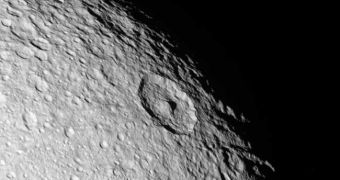The planets and the moons in the solar system often get pounded by differently sized objects, creating large cracks and craters on their surface. These energetic impacts are often due to the moon's regular motion and spinning. To better understand the effect that these events have on the motion of a planet or moon, imagine a spherical object with a hole on one of its sides. The statistical calculations show that such an object rolling over a flat surface will stop most of the time in a position which favors the hole, due to the fact that the opposite side has more mass, thus being heavier.
If the study is redirected to a planet or a moon, one will notice that the planet stabilizes its tilt in a way that the crater created by an object will end up in the nearest pole. Researchers calculate that impacting objects might have influenced the tilt of two of Saturn's moons, Tethys and Rhea and one of the moons in the orbit of Uranus, Titania, by altering their tilt by 4, 7 respectively 12 degrees, after receiving impacts that have created relatively large craters.
Though the effects on the moons might seem minor, these events could have boosted the stress in the interior of the moons, which in terms created large fractures across the plate tectonics. Scientists have also made theoretical calculations of how an object the size of Pluto would behave considering that they would have suffered an impact that could create a crater as large as those observed on Saturn's moons, thus showing that objects with relatively small spin speeds are more likely to experience a shift in the tilt. The effect of speed on an object's spin is well known, as objects with high spin speed have a better chance of keeping the axis tilt stable, when subjected to exterior influence.
Pluto and its satellite Charon could present a change in tilt as high as 10 to 20 degrees, if they were to suffer an impact that could create a crater as large as those on Saturn's moons. So far the predictions are purely theoretical, but might be tested in 2015, when NASA's New Horizons will execute a fly-by near Pluto and its moons.
The same predictions could be applied for our natural satellite and astronomers believe that the Moon might have suffered multiple changes in its tilt in its past, while being impacted by different objects. Nevertheless the theory does not take into consideration the fact that the matter blown away by the impactor might have settled back on the surface around the formed crater which could cancel out any instabilities in its tilt or reduce them by a factor of five.
Nevertheless, there would still be a visible effect and a change in tilt. This theory also poses another hidden secret, as our moon is no more special than the others, when it comes to being struck by asteroids or comets. A large crater in the Aitken basin near its south pole might trigger a future roll in the Moon's tilt.

 14 DAY TRIAL //
14 DAY TRIAL //